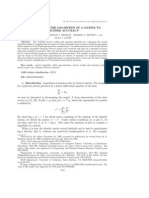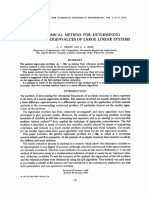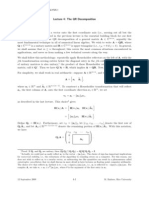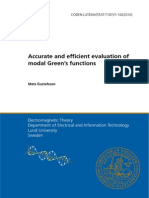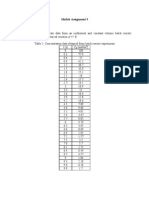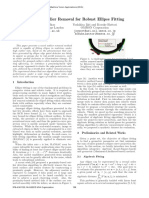Safe and Effective Determinant Evaluation: February 25, 1994
Safe and Effective Determinant Evaluation: February 25, 1994
Uploaded by
David ImmanuelCopyright:
Available Formats
Safe and Effective Determinant Evaluation: February 25, 1994
Safe and Effective Determinant Evaluation: February 25, 1994
Uploaded by
David ImmanuelOriginal Title
Copyright
Available Formats
Share this document
Did you find this document useful?
Is this content inappropriate?
Copyright:
Available Formats
Safe and Effective Determinant Evaluation: February 25, 1994
Safe and Effective Determinant Evaluation: February 25, 1994
Uploaded by
David ImmanuelCopyright:
Available Formats
Safe and Eective Determinant Evaluation
Kenneth L. Clarkson
AT&T Bell Laboratories
Murray Hill, New Jersey 07974
e-mail: clarkson@research.att.com
February 25, 1994
Abstract
The problem of evaluating the sign of the determinant of a small
matrix arises in many geometric algorithms. Given an n n matrix
A with integer entries, whose columns are all smaller than M in Eu-
clidean norm, the algorithm given here evaluates the sign of the deter-
minant det A exactly. The algorithm requires an arithmetic precision of
less than 1.5n+2 lg M bits. The number of arithmetic operations needed
is O(n
3
) + O(n
2
) log OD(A)/, where OD(A)| det A| is the product of
the lengths of the columns of A, and is the number of extra bits of
precision,
min{lg(1/u) 1.1n 2 lg n 2, lg N lg M 1.5n 1},
where u is the roundo error in approximate arithmetic, and N is the
largest representable integer. Since OD(A) M
n
, the algorithm requires
O(n
3
lg M) time, and O(n
3
) time when = (log M).
1 Introduction
Many geometric algorithms require the evaluations of the determinants of small
matrices, and testing the signs () of such determinants. Such testing is fun-
damental to algorithms for nding convex hulls, arrangements of lines and line
segments and hyperplanes, Voronoi diagrams, and many others. By such nu-
merical tests, a combinatorial structure is dened. If the tests are incorrect, the
resulting structure may be wildly dierent from a sensible result[11, 6], and
programs for computing the structures may crash.
Two basic approaches to this problem have been proposed: the use of exact
arithmetic, and the design of algorithms to properly use inaccurate numerical
tests. While the former solution is general, it can be quite slow: naively, n-tuple
precision appears to be necessary for exact computation of the determinant of an
nn matrix with integer entries. While adaptive precision has been proposed
and used[7], the resulting code and time complexity are still substantially larger
than one might hope.
1
The second approach is the design (or redesign) of algorithms to use limited
precision arithmetic and still guarantee sensible answers. (For example, [4, 2,
13, 6, 14, 12, 11, 9, 17].) Such an approach can be quite satisfactory, when
obtainable, but seems applicable only on an ad hoc and limited basis: results
for only a fairly restricted collection of algorithms are available so far.
This paper takes the approach of exact evaluation of the sign of the deter-
minant, or more generally, the evaluation of the determinant with low relative
error. However, the algorithm requires relatively low precision: less than 3n/2
bits, and additionally some number more bits than were used to specify the ma-
trix entries. The algorithm is naturally adaptive, in the sense that the running
time is proportional to the logarithm of the orthogonality defect OT(A) of the
matrix A, where
OT(A)
1in
|a
i
|
[ det A[
.
Here a
i
is the ith column of A. (We let |a
i
|
_
a
2
i
denote the Euclidean norm
of a
i
, with a
2
i
a
i
a
i
.) In geometric problems, the orthogonality defect may be
small for most matrices, so such adaptivity should be a signicant advantage in
running time. Note that the limited precision required by the algorithm implies
that native machine arithmetic can be used and still allow the input precision
to be reasonably high. For example, the algorithm can handle 10 10 matrices
with 32-bit entries in the 53 bits available in double precision on many modern
machines.
The algorithm is amenable to rank-one updates, so det B can be evaluated
quickly (in about O(n
2
) time) after det A is evaluated, if B is the same as A in
all but one column.
One limitation of the approach here is that the matrix entries are required
to be integers, rather than say rational numbers. This may entail preliminary
scaling and rounding of input to a geometric algorithm; this limitation can be
ameliorated by allowing input expressed in homogeneous coordinates, as noted
by Fortune[1]. The resulting output is plainly the output for inputs that are
near the originals, so such an algorithm is stable in Fortunes sense.[2]
The new algorithm uses ideas from Lovaszs basis reduction scheme [8, 10,
16], and can be viewed as a low-rent version of that algorithm: a result of
both algorithms is a new matrix A
, produced by elementary column operations,
whose columns are roughly orthogonal. However, basis reduction does not allow
a column of A to be replaced by an integer multiple of itself: the resulting
set of matrix columns generates only a sublattice of the lattice generated by
the columns of A. Since here only the determinant is needed, such a scaling
of a column is acceptable since the scaling factor can be divided out of the
determinant of the resulting matrix. Thus the problem solved here is easier
than basis reduction, and the results are sharper with respect to running time
and precision. The algorithm here yields a QR factorization of A, no matter
what the condition of A, and so may be of interest in basis reduction, since
Lovaszs algorithm starts by nding such a factorization. In practice, that initial
factorization is found as an approximation using oating-point arithmetic; if the
2
matrix MGS(matrix A)
for k := 1 upto n do
c
k
:= a
k
;
for j := k 1 downto 1 do c
k
= a
j
(c
k
/c
j
);
return C;
Figure 1: A version of the modied Gram-Schmidt procedure.
matrix is ill-conditioned, the factorization procedure may fail.
Schnorr has given an algorithm for basis reduction requiring O(n+lg M) bits;
his algorithm for this harder problem is more complicated, and his constants
are not as sharp.[15]
2 The algorithm
The algorithm is an adaptation of the modied Gram-Schmidt procedure for
computing an orthogonal basis for the linear subspace spanned by a set of vec-
tors. The input is the matrix A = [a
1
a
2
. . . a
n
] with the column n-vectors a
i
,
i = 1 . . . n. One version of the modied Gram-Schmidt procedure is shown in
Figure 1. We use the operation a/b for two vectors a and b, with a/b (a b)/b
2
.
Note that (a + b)/c = a/c + b/c, and (a (a/c)c) c = 0. Implemented in ex-
act arithmetic, this procedure yields an orthogonal matrix C = [c
1
c
2
. . . c
n
],
so c
i
c
j
= 0 for i ,= j, such that a
k
= c
k
+
1j<k
R
jk
c
j
, for some values
R
jk
= a
k
/c
j
. (In variance with some usage, in this paper orthogonal matrices
have pairwise orthogonal columns: they need not have unit length. If they do,
the matrix will be termed orthonormal.)
The vector c
k
is initially a
k
, and is then reduced by the c
j
components of a
k
:
after step j of the inner loop, c
k
c
j
= 0. Note that even though a
j
is used in the
reduction, rather than c
j
, the condition c
k
c
i
= 0 for j < i < k is unchanged,
since a
j
has no c
i
components for i > j.
Since A = CR where R is unit upper triangular, det A = det C; since C is
an orthogonal matrix, [ det C[ =
1jn
|c
j
|, and it remains only to determine
the sign of the determinant of a perfectly conditioned matrix.
When the same algorithm is used with oating-point arithmetic to nd a
matrix B approximating C, the algorithm may fail if at some stage k a column
b
k
of B is very small: the vector a
k
is very nearly a linear combination of the
vectors a
1
, . . . , a
k1
: it is close to the linear span of those vectors. Here the
usual algorithm might simply halt and return the answer that the determinant
is nearly zero. However, since b
k
is small, we can multiply a
k
by some large
scaling factor s, reduce sa
k
by its c
j
components for j < k, and have a small
resulting vector. Indeed, that vector will be small even if we reduce using
rounded coecients for a
j
. With such integer coecients, and using the columns
3
oat det safe(matrix A)
oat denom := 1;
S
b
:= 0;
for k := 1 upto n do
loop
b
k
:= a
k
;
for j := k 1 . . . 1 b
k
= a
j
(b
k
/b
j
);
if a
2
k
2b
2
k
then S
b
+= b
2
k
; exit loop;
s := S
b
/4(b
2
k
+ 2
k
a
2
k
);
s := mins, (N/1.58
k
S
b
)
2
/a
2
k
;
if s < 1/2 then s := 1 else s :=
s |;
if s = 1 and a
2
k
0.9S
b
then s := 2;
denom = s;
a
k
= s;
for j := k 1 . . . 1 a
k
= a
j
(a
k
/b
j
)|;
if a
k
= 0 then return 0;
end loop;
return det approx(B)/denom;
Figure 2: An algorithm for estimating det A with small relative error.
a
j
and exact arithmetic for the reduction steps, det A remains unchanged, except
for being multiplied by the scaling factor s.
Thus the algorithm given here proceeds in n stages as in modied Gram-
Schmidt, processing a
k
at stage k. First the vector b
k
is found, estimating the
component of a
k
orthogonal to the linear span of a
1
, . . . , a
k1
. A scaling
factor s inversely proportional to |b
k
| is computed, and a
k
is replaced by sa
k
and then reduced using exact elementary column operations that approximate
Gram-Schmidt reduction. The result is a new column a
k
= s c
k
+
1j<k
j
c
j
,
where c
k
is the old value of that vector, and the coecients
j
1/2. Hence the
new a
k
is more orthogonal to earlier vectors than the old one. The processing
of a
k
repeats until a
k
is nearly orthogonal to the previous vectors a
1
, . . . , a
k1
,
as indicated by the condition a
2
k
2b
2
k
.
The algorithm is shown in Figure 2. All arithmetic is approximate, with
unit roundo u, except the all-integer operations a
k
= s and the reduction
steps for a
k
(although a
k
/b
j
is computed approximately). The value N is no
more than the largest representable integer. For a real number x, the integer
x| is the least integer no smaller than x, and x| is x 1/2|. The quantity
k
is dened in Notation 3.4 below.
4
The precision requirements of the algorithm can be reduced somewhat by
reorthogonalization, that is, simply applying the reduction step to b
k
again
after computing it, or just before exiting the loop for stage k. Homan discusses
and analyzes this technique; his analysis can be sharpened in our situation.[5]
Note that the condition a
2
k
2b
2
k
may hold frequently or all the time; if the
latter, the algorithm is very little more than Modied Gram-Schmidt, plus the
procedure for nding the determinant of the very-well-conditioned matrix B.
3 Analysis
The analysis requires some elementary facts about the error in computing the
dot product and Euclidean norm.
Lemma 3.1 For n-vectors a and b and using arithmetic with roundo u, a b
can be estimated with error at most 1.01nu|a||b|, for nu .01. The rela-
tive error in computing a
2
is therefore 1.01nu, under these conditions. The
termination condition for stage j implies a
2
j
2b
2
j
(1 + 2.03nu).
Proof: For a proof of the rst statement, see [3], p. 35. The remaining
statements are simple corollaries.
Well need a lemma that will help bound the error due to reductions using
b
j
, rather than c
j
.
Lemma 3.2 For vectors a, b, and c, let d b c, and let |d|/|b|. Then
a/b a/c |a||d|/|c||b| = |a|/|c|.
Note also a/b |a|/|b|.
Proof: The Cauchy-Schwartz inequality implies the second statement, and
also implies
a/b a/c |a||b/b
2
c/c
2
|.
Using elementary manipulations
b
b
2
c
c
2
=
(dc
2
cd c) c(d c + d
2
)
c
2
b
2
.
The two terms in the numerator are orthogonal, so the norm of this vector is
_
(dc
2
cd c)
2
+ c
2
(d c + d
2
)
2
c
2
b
2
=
c
2
d
2
b
2
c
2
b
2
= /|c|,
as desired.
Lemma 3.3 For vectors a, b and c, and d, and as in the previous lemma,
suppose a
2
2b
2
(1 + ), a/c = 1, and < 1. Then |a b|/|b| 1 + 4 + .
5
Proof: We have
(a b)
2
b
2
=
a
2
2a b + b
2
b
2
3 + 2 2a b/b
2
,
using a
2
2b
2
(1 + ). By the assumption a/c = 1,
a b
b
2
=
a (c + d)
b
2
=
c
2
+ a d
b
2
(1 )
2
_
2(1 + ),
where the last inequality follows using the triangle and Cauchy-Schwartz in-
equalities and the assumption a
2
2b
2
(1 + ). Hence
(a b)
2
b
2
3 + 2 2((1 )
2
_
2(1 + )) 1 + 2 + 8,
giving |a b|/|b| 1 + 4 + , as claimed.
Notation 3.4 Let
3(n + 2)u,
and for j = 1 . . . n, let
j
L
j
,
where
L
2
j
j
2
(
2
+ 2.04)
j1
,
and
1.58.
Let
1 + 2.04/
2
.
Let
d
k
b
k
c
k
for k = 1 . . . n.
Theorem 3.5 Suppose the reductions for b
k
are performed using rounded arith-
metic with unit roundo u. Assume that (n + 2)u < .01 and
n
< 1/32. (For
the latter, lg(1/u) 1.1n + 2 lg n + 7 suces.) Then:
(i) |b
k
a
j
(b
k
/b
j
)| 1.54|b
k
|.
(ii) The computed value of a single reduction step for b
k
, or b
k
(b
k
/b
j
)a
j
,
diers from the exact value by a vector of norm no more than |b
k
|.
Before a reduction of b
k
by a
j
, |b
k
| |a
k
|
k1j
.
(ii) After the reduction loop for b
k
, d
k
satises
|d
k
|
k
|a
k
|/
2,
and after stage k, |d
k
|
k
|b
k
|.
6
Proof: First, part (i): let
a
j
(a
j
b
j
) ((a
j
b
j
)/b
j
)b
j
,
which is orthogonal to b
j
, and express b
k
a
j
(b
k
/b
j
) as
b
k
(b
k
/b
j
)b
j
(b
k
/b
j
)a
j
(b
k
/b
j
)((a
j
b
j
)/b
j
)b
j
.
Since b
2
k
=
2
+
2
b
2
j
+
2
(a
j
)
2
, for some , = b
k
/b
j
, and = b
k
/a
j
, we have
(b
k
(b
k
/b
j
)(b
j
+ a
j
))
2
=
2
+ ( )
2
(a
j
)
2
,
and so
(b
k
(b
k
/b
j
)(b
j
+ a
j
))
2
/b
2
k
( )
2
/(
2
b
2
j
/(a
j
)
2
+
2
),
which has a maximum value
1 + (a
j
)
2
/b
2
j
2 + 4
j
+ 2.03nu,
and so
|b
k
(b
k
/b
j
)(b
j
+ a
j
)| 1.47|b
k
|. (1)
Using part (ii) inductively and Lemmas 3.3 and 3.1, and the assumption
j
1/32,
|(b
k
/b
j
)((a
j
b
j
)/b
j
)b
j
|
|b
k
|
b
2
j
(a
j
c
j
d
j
) (c
j
+ d
j
)
=
|b
k
|
b
2
j
(c
j
d
j
+ d
j
(a
j
b
j
))
|b
k
|(
j
(1 +
j
) +
j
(1 + 4
j
+ 2.03nu))
|b
k
|
j
(2.15)
Thus with (1),
|b
k
a
j
(b
k
/b
j
)| (1.47 + 2.15/32)|b
k
| 1.54|b
k
|.
This completes part (i).
Now for part (ii). From Lemma 3.1 and Lemma 3.2, the error in computing
b
k
/b
j
= b
k
b
j
/b
2
j
is at most
((1 +u)(1 + 2.03nu) 1)|b
k
|/|b
j
|,
and |a
j
|
2(1+1.02nu)|b
j
|, and so the dierence between a
j
(b
k
b
j
/b
2
j
) and
its computed value is a vector with norm no more than |b
k
| times
2(1 + 1.02nu)((1 +u)
2
(1 + 2.03nu) 1) (2)
< 2.9002(n + 1)u (3)
7
A reduction step computes the nearest oating-point vector to b
k
a
j
(b
k
/b
j
)+.
Hence the error is a vector +
, where
|
| u|b
k
a
j
(b
k
/b
j
) + |
u(|b
k
a
j
(b
k
/b
j
)| +||).
With this and (2), the computed value of b
k
after the reduction step, diers
from its real value by a vector that has norm no more than |b
k
| times
2.9002(n + 1)u(1 +u) + 1.54u
< 3(n + 2)u
= .
Using part (i), the norm of b
k
after the reduction step is no more than (1.54 + )|b
k
| < |b
k
|.
We turn to part (iii), using (ii) and inductively (iii) for j < k. (We have
d
1
= 0 for the inductive basis.)
The vector b
k
is initially a
k
, which is c
k
plus a vector in the linear span of
a
1
. . . a
k1
, which is the linear span of c
1
. . . c
k1
. When b
k
is reduced by a
j
, it
is replaced by a vector
b
k
(b
k
/b
j
)a
j
+
j
, (4)
where
j
is the roundo. Except for
j
, the vector b
k
c
k
continues to be in
the linear span of c
1
. . . c
k1
. Hence d
k
b
k
c
k
can be expressed as e
k
+,
where e
k
=
1j<k
j
c
j
, for some values
j
, and is no longer than the sum
of the roundo vectors, so
|| |a
k
|
k1
/( 1), (5)
using part (ii). From the triangle inequality,
d
2
k
(|e
k
| + )
2
. (6)
The quantity
j
is
1
c
j
[b
k
(b
k
/c
j
)a
j
+ (b
k
/c
j
)a
j
(b
k
/b
j
)a
j
]
= b
k
/c
j
b
k
/b
j
,
where b
k
is the value of that vector for the a
j
reduction. (Note that except for
roundo, b
k
/c
j
does not change after the reduction by a
j
.) By Lemma 3.2 and
this part of Theorem 3.5 as applied to d
j
,
[
j
[ |b
k
|
j
/|c
j
|, (7)
Using part (ii) and (7),
e
2
k
=
1j<k
2
j
c
2
j
1j<k
2
j
2(k1j)
a
2
k
.
8
Using (5),(6), and
j
< L
j
,
d
2
k
a
2
k
2k
2
2
_
_
1
1
+
1j<k
L
2
j
/
2j
_
_
2
. (8)
It suces for part (iii) that
k
k
_
2(1 + )
_
_
1
1
+
1j<k
L
2
j
/
2j
_
_
,
where the (1 + ) term allows the statement
d
2
k
2
k
a
2
k
/2(1 + 2.03nu). (9)
Letting M
k
= L
k
/
k
, we need
M
k
1
k
+
_
2(1 + )
_
_
1
1
+
1j<k
M
2
j
_
_
,
Since L
1
= 1 allows
|d
1
| = 0 =
1
= ,
M
k
=
_
j(1 + 2(1 + )/
2
)
k1
, or L
2
k
= k
2
(
2
+ 2.04)
k1
for k > 1, gives
suciently large
k
, using the facts
1j<k
jx
j1
=
kx
k1
x 1
x
k
1
(x 1)
2
and
x y
x y/2
x.
The last statement of part (iii) follows from the termination condition for
stage k, which from Lemma 3.1 implies a
2
k
2b
2
k
(1 + 2.03nu) < 2b
2
k
(1 + ).
Lemma 3.6 With Notation 3.4 and the assumptions of Theorem 3.5, let S
c
k
1j<k
c
2
j
and S
b
k
the computed value of
1j<k
b
2
j
. Then
[S
c
k
S
b
k
[/S
k
c
< 1/10.
Proof: With Theorem 3.5(iii), we have
b
2
j
/c
2
j
1/(1
j
)
2
,
implying
1j<k
b
2
j
/S
c
k
1/(1
j
)
2
.
9
Lemma 3.1 implies S
b
k
/
1j<k
b
2
j
1 + 1.03(k + n)u, and so
S
b
k
S
c
k
1 + 1.03(k + n)u
(1
j
)
2
,
implying S
b
k
S
c
k
< S
c
k
/10. A similar argument shows that S
c
k
S
b
k
< S
c
k
/10.
For the remaining discussion well need even more notation:
Notation 3.7 Let
f
k
a
k
%c
k
a
k
(a
k
/c
k
)c
k
,
so that a
k
= c
k
+f
k
, c
k
and f
k
are perpendicular, and a
2
k
= c
2
k
+f
2
k
. Suppose a
reduction loop for a
k
is done. Let a
k
denote a
k
before scaling it by s, and let c
k
and
f
k
denote the components c
k
and f
k
at that time. Let a
(j)
k
denote the vector
a
k
when reducing by a
j
, so a
(k1)
k
is a
k
before the reduction loop, and a
(0)
k
is a
k
after the reduction loop. Well use z
jk
to refer to a computed value of a
k
/b
j
.
Lemma 3.8 With assumptions as in the previous theorem, before a reduction
of a
k
by a
j
,
|a
k
| s| a
k
|
k1j
+ (3/4)
j<i<k
|c
i
|
i1j
.
Proof: When reducing by a
j
, a
k
= a
(j)
k
is replaced by
a
(j1)
k
= a
k
z
jk
a
j
+ a
j
,
for some [[ 1/2. As in Theorem 3.5(ii), the norm of a
k
z
jk
a
j
is no more
than |a
k
|, so
|a
(j1)
k
| |a
(j)
k
| +|a
j
|/2.
Thus
|a
(j)
k
| s| a
k
|
k1j
+
j<i<k
|a
i
|
i1j
/2
s| a
k
|
k1j
+ (3/4)
j<i<k
|c
i
|
i1j
, (10)
where the last inequality follows from Lemma 3.1 and Theorem 3.5(ii).
Lemma 3.9 With the assumptions of Theorem 3.5, in a reduction loop for a
k
,
c
2
k
0.55 a
2
k
and
f
2
k
0.45 a
2
k
.
10
Proof: Since the reduction loop is done, the conditional a
2
k
2b
2
k
returned
false. Therefore, using Theorem 3.5(iii) and reasoning as in Lemma 3.1,
| a
k
| >
2|b
k
|(1 2.03nu)
2(| c
k
|
k
| a
k
|/
2)(1 2.03nu),
which implies
c
2
k
0.55 a
2
k
, (11)
using the assumption
k
< 1/32. The last statement of the lemma follows from
a
2
k
= c
2
k
+
f
2
k
.
Theorem 3.10 With assumptions as Theorem 3.5, after the reduction loop for
a
k
it satises
a
2
k
max a
2
k
, 2.6S
c
k
.
Also
S
c
k
M
2
(3.3)
k2
.
The condition
lg N lg M + 1.5n + 1
allows the algorithm to execute.
Proof: We begin by bounding the c
j
components of a
k
for j < k, and use
these to bound |f
k
|, after the reduction loop. Note that the c
j
component of
a
k
remains xed after the reduction of a
k
by a
j
. That is, using Notation 3.7,
a
(0)
k
/c
j
= a
(j1)
k
/c
j
= (a
(j)
k
z
jk
|a
j
)/c
j
.
Using a
j
/c
j
= 1, this implies
[a
(0)
k
/c
j
[
[a
(j)
k
/c
j
a
(j)
k
/b
j
[ +[a
(j)
k
/b
j
z
jk
|[
|a
(j)
k
|
j
/|c
j
| +
_
1/2 + 2.2(n + 1)u|a
(j)
k
|/|c
j
|
_
< 1/2 +|a
(j)
k
|(
j
+ )/|c
j
|, (12)
where the next-to-last inequality follows from Theorem 3.5(iii) and from rea-
soning as for (2). Since
f
2
k
= |a
(0)
k
|
2
s
2
c
2
k
=
1j<k
(a
(0)
k
/c
j
)
2
c
2
j
,
and the triangle inequality implies |x+y|
2
(|x|+|y|)
2
, we have f
2
k
no more
than
1j<k
(|c
j
|/2 +|a
(j)
k
|(
j
+ ))
2
_
_
S
c
k
/2 +
1j<k
(|a
(j)
k
|(
j
+ ))
2
_
2
. (13)
11
From the denition of
j
and (10),
1j<k
|a
(j)
k
|
2
(
j
+ )
2
2
k
1j<k
_
s| a
k
|
kj
+
3
4
j<i<k
|c
i
|
ij
_
2
(
2
)
j
2
k
_
_
1j<k
s
2
a
2
k
2k
j
+
3
4
1j<k
_
j<i<k
|c
i
|
i
_
2
j
_
_
2
2
k
(s| a
k
|/
2 + 3
_
S
c
k
/4)
2
With (13), f
2
k
is no more than
_
_
S
c
k
/2 +
k
(s| a
k
|/
2 + 3
_
S
c
k
/4)
_
2
_
_
S
c
k
(1/2 +
k
) + 1.2
k
s| a
k
|
_
2
. (14)
If s = 1, then using Lemma 3.9 and
k
1/32,
a
2
k
= c
2
k
+ f
2
k
0.55 a
2
k
+ (
_
S
c
k
(1/2 +
k
) + 1.2
k
| a
k
|)
2
0.55 a
2
k
+ (0.54
_
S
c
k
+ 1.2| a
k
/32|)
2
max a
2
k
, S
c
k
. (15)
If s = 2 because the conditional s = 1 and a
2
k
0.9S
b
returned true,
then | a
k
| 1.01
_
S
c
k
, and
a
2
k
4(0.55) a
2
k
+ (
_
S
c
k
(1/2 +
k
) + 2(1.2)
k
| a
k
|)
2
(16)
2.6S
c
k
. (17)
Now suppose s > 1 and the conditional s = 1 and a
2
k
0.9S
b
returned
false. By Theorem 3.5(iii), c
2
k
b
2
k
+ 2
k
a
2
k
, so that when
s| is evaluated it
is no more than
_
S
b
/4c
2
k
(1.03) + 1/2, where the 1.03 factor bounds the error
in computing s. Thus
c
2
k
s
2
c
2
k
(
_
S
b
/4(1.03) +| c
k
|/2)
2
(0.55
_
S
c
k
+| c
k
|/2)
2
(0.55
_
S
c
k
+ 0.375| a
k
|)
2
, (18)
using Lemma 3.9. When
s| is evaluated, it is smaller than
1.03
_
S
b
/4
k
a
2
k
+ 1/2,
12
and so
s
k
| a
k
| 0.55
_
k
S
c
k
+
k
| a
k
|/2.
With (14) and the assumption
k
1/32,
f
2
k
(
_
S
c
k
(1/2 +
k
) + 0.55
_
k
S
c
k
+
k
| a
k
|/2)
2
(0.63
_
S
c
k
+
k
| a
k
|/2)
2
, (19)
and so with (18),
a
2
k
= c
2
k
+ f
2
k
(0.55
_
S
c
k
+ 0.375| a
k
|)
2
+ (0.63
_
S
c
k
+| a
k
|/64)
2
max a
2
k
, 1.4S
c
k
. (20)
With (15), (16), and (20), we have a
2
k
max a
2
k
, 2.6S
c
k
. First we show that
c
2
k
max c
2
k
, 2.2S
c
k
. It remains to bound S
c
k
inductively. If s = 1 then c
2
k
= c
2
k
.
If s = 2 because the conditional s = 1 and a
2
k
0.9S
b
returned true, then
c
2
k
2.2S
c
k
. If s > 1 and the conditional s = 1 and a
2
k
0.9S
b
returned
false, then with (18),
c
2
k
(0.55
_
S
c
k
+| c
k
|/2)
2
max c
2
k
, 2.2S
c
k
,
Let
c
k
be an upper bound for S
c
k
, so
c
2
= M
2
suces, and when stage k is
nished,
c
k+1
=
c
k
+ 2.2
c
k
is large enough, so
c
k
= (3.2)
k2
M
2
is an upper
bound for S
c
k
.
Theorem 3.11 Let be the minimum of
lg(1/u) 1.1n 2 lg n 2
and
lg N lg M 1.5n 1.
(The conditions of Theorems 3.5 and 3.10 are implied by > 4.) The algorithm
requires O(n
3
) + O(n
2
) log OT(A)/ time.
Proof: Clearly each iteration of the main loop requires O(n
2
) time. The idea
is to show that for each stage k, the loop body is executed O(1) times except
for executions that reduce OT(A) by a large factor; such reductions may occur
when a
k
is multiplied by a large scale factor s, increasing det A, or by reducing
|a
k
| substantially when s is small.
We consider some cases, remembering that c
2
k
never decreases during stage k.
The discussion below assumes that S
b
/4(b
2
k
+2
k
a
2
k
) evaluates to no more than
(N/1.58
k
S
b
)
2
/a
2
k
; if not, s is limited by the latter, and is bounded to the
second term in its denition.
s > 2, b
2
k
k
a
2
k
.
After two iterations with this condition, either s 2 or c
2
k
will be suciently
large that 2b
2
k
a
2
k
.
13
s > 2, b
2
k
k
a
2
k
.
Here (19) and Lemma 3.9 show that
|f
k
| 0.62
_
S
c
k
+
k
| a
k
|/2,
and s > 2 implies
k
| a
k
|/2
k
_
S
b
/
k
/
_
4(2.5)2/2 < 0.04
_
S
c
k
,
so | a
k
| 0.66
_
S
c
k
/
.45 <
_
S
c
k
during the second iteration under these con-
ditions. Thus s 0.37/
k
here for all but possibly the rst iteration, while a
2
k
is bounded. Hence lg OT(A) decreases by 0.5 lg(1/
k
) 2 during these steps.
s 2.
From (14) and Lemma 3.9,
|f
k
| (1/2 +
k
)
_
S
c
k
+ 2.4
k
|
f
k
|/
.45
0.54
_
S
c
k
+ 4delta
k
|
f
k
|,
so y
k
|f
k
|/0.54
_
S
c
k
converges to 1/(1 4
k
).
Suppose y
k
1/(4
k
)
2
/(1 4
k
); here s = 1, and y
k
decreases by a factor
of 4
k
/(1 4
k
) 4.6
k
at each reduction loop. Hence |a
k
| is reduced by a
factor of 4.6
k
, while det A remains the same. Hence lg OT(A) decreases by at
least lg(1/
k
) 2.3.
Suppose y
k
< 1/(4
k
)
2
/(1 4
k
); then in O(1) (less than 7) reductions,
y
k
1.01/(1 4
k
), so that
a
2
k
f
2
k
/0.45
1.01(0.54)
2
S
c
k
/(1 4
k
)
2
/0.45
0.75S
c
k
,
and so the conditional a
2
k
0.9S
b
will return true. Thereafter O(1) execu-
tions suce before stage k completes, as c
k
doubles in magnitude at each step.
Here is one way to get the estimate det approx(B): estimate the norms |b
i
|,
normalize each column of B to obtain a matrix
B with columns
b
j
b
j
/|b
j
|,
for j = 1, . . . , n, and then return det
B 1 times
1in
|b
i
|. To suggest
that det
B can be estimated using low-precision arithmetic, we show that indeed
[ det
B[ 1 and that the condition number of
B is small. In the proof, we use
the matrix
C whose columns are c
j
c
j
/|c
j
|, for j = 1, . . . , n. (Note that
the truly orthonormal matrix
C has det
C = 1 and Euclidean condition number
2
(
C) = 1.)
Theorem 3.12 With assumptions as in Theorem 3.5, for any x R
n
,
[|
B
T
x|/|x| 1[ 1.68
n
,
and so [ det
B[ 1 2n
n
, and
B has condition number
2
(
B) 1 + 3
n
.
14
Proof: Its easy to show that for x R
n
,
[
b
j
x c
j
x[ (
j
+ )|x|,
where the on the right accounts for roundo in computing
b
j
from b
j
. Thus
(
B
T
x
C
T
x)
2
x
2
1jn
(
j
+ )
2
x
2
2
n
1jn
(
2
+ 2.04)
j1
2
2
n
x
2
.
Since |
C
T
x| = |x|,
[|
B
T
x|/|x| 1[
2
n
.
Recall that
B
T
and
B have the same singular values.[3] Since the bound above
holds for any x, the singular values
j
of
B satisfy [
j
1[
n
, for j = 1, . . . , n,
and so
2
(
B) =
1
/
n
1 +
2
n
1
2
n
1 + 3
n
,
using (1 + x)/(1 x) = 1 + 2x/(1 x) and 1/(1 x) increasing in x. Since
[ det
B[ =
1
2
n
, we have
[ det
B[ (1
2
n
)
n
exp(1.5n
n
) 1 1.5n
n
,
where we use 1 x exp(x
log(1)
) for 0 < x < 1.
With these results, it is easy to show that Gaussian elimination with partial
pivoting can be used to nd det
B, using for example the backwards error bound
that the computed factors L and U have LU =
B+, where is a matrix with
norm no more than n
2
n2
n1
|
B|u; this implies, as above, that the singular
values, and hence the determinant, of LU are close to B.
Acknowledgements
Its a pleasure to thank Steve Fortune, John Hobby, Andrew Odlyzko, and
Margaret Wright for many helpful discussions.
References
[1] S. Fortune. personal communication.
[2] S. Fortune. Stable maintenance of point-set triangulations in two dimen-
sions. In Proc. 30th IEEE Symp. on Foundations of Computer Science,
pages 494499, 1989.
[3] G. H. Golub and C. F. Van Loan. Matrix Computations. Johns Hopkins
University Press, Baltimore and London, 1989.
15
[4] D. Greene and F. Yao. Finite-resolution computational geometry. In Proc.
27th IEEE Symp. on Foundations of Computer Science, pages 143152,
1986.
[5] W. Homan. Iterative algorithms for Gram-Schmidt orthogonalization.
Computing, 41:335348, 1989.
[6] C. Homann, J. Hopcroft, and M. Karasick. Robust set operations on
polyhedral solids. IEEE Comp. Graph. Appl., 9:5059, 1989.
[7] M. Karasick, D. Lieber, and L. Nackman. Ecient delaunay triangulation
using rational arithmetic. ACM Transactions on Graphics, 10:7191, 1990.
[8] A. K. Lenstra, H. W. Lenstra, and L. Lovasz. Factoring polynomials with
rational coecients. Math. Ann., 261:515534, 1982.
[9] Z. Li and V. Milenkovic. Constructing strongly convex hulls using exact
or rounded arithmetic. In Proc. Sixth ACM Symp. on Comp. Geometry,
pages 235243, 1990.
[10] L. Lovasz. An algorithmic theory of numbers, graphs, and complexity.
SIAM, Philadelphia, 1986.
[11] V. Milenkovic. Veriable implementations of geometric algorithms using
nite precision arithmetic. Articial Intelligence, 37:377401, 1988.
[12] V. Milenkovic. Veriable Implementations of Geometric Algorithms using
Finite Precision Arithmetic. PhD thesis, Carnegie Mellon U., 1988.
[13] V. Milenkovic. Double precision geometry: a general technique for calculat-
ing line and segment intersections using rounded arithmetic. In Proc. 30th
IEEE Symp. on Foundations of Computer Science, pages 500505, 1989.
[14] D. Salesin, J. Stol, and L. Guibas. Epsilon geometry: building robust
algorithms from imprecise calculations. In Proc. Seventh ACM Symp. on
Comp. Geometry, pages 208217, 1989.
[15] C. P. Schnorr. A more ecient algorithm for lattice basis reduction. J.
Algorithms, 9:4762, 1988.
[16] A. Schrijver. Theory of Linear and Integer Programming. Wiley, New York,
1986.
[17] K. Sugihara and M. Iri. Geometric algorithms in nite-precision arithmetic.
Technical Report RMI 88-10, U. of Tokyo, 1988.
16
You might also like
- Surfactant PDFDocument11 pagesSurfactant PDFqwertyNo ratings yet
- Approximating The Logarithm of A Matrix To Specified AccuracyDocument14 pagesApproximating The Logarithm of A Matrix To Specified AccuracyfewieNo ratings yet
- KIL1005: Numerical Methods For Engineering: Semester 2, Session 2019/2020 7 May 2020Document16 pagesKIL1005: Numerical Methods For Engineering: Semester 2, Session 2019/2020 7 May 2020Safayet AzizNo ratings yet
- Sparse Implementation of Revised Simplex Algorithms On Parallel ComputersDocument8 pagesSparse Implementation of Revised Simplex Algorithms On Parallel ComputersKaram SalehNo ratings yet
- Loss and Recapture of Orthogonality in The Modified Gram-Schmidt AlgorithmDocument15 pagesLoss and Recapture of Orthogonality in The Modified Gram-Schmidt AlgorithmS.Abinith NarayananNo ratings yet
- Strassen AlgorithmDocument4 pagesStrassen AlgorithmMahesh YadavNo ratings yet
- An Ecient Parallel Version of The Householder-QL Matrix Diagonalisation AlgorithmDocument14 pagesAn Ecient Parallel Version of The Householder-QL Matrix Diagonalisation AlgorithmShashi KantNo ratings yet
- Time Harmonic Maxwell EqDocument16 pagesTime Harmonic Maxwell Eqawais4125No ratings yet
- Node ReorderingDocument27 pagesNode Reorderingedi18No ratings yet
- Applications of Random SamplingDocument35 pagesApplications of Random Samplingvanessita578No ratings yet
- Local Search in Smooth Convex Sets: CX Ax B A I A A A A A A O D X Ax B X CX CX O A I J Z O Opt D X X C A B P CXDocument9 pagesLocal Search in Smooth Convex Sets: CX Ax B A I A A A A A A O D X Ax B X CX CX O A I J Z O Opt D X X C A B P CXhellothapliyalNo ratings yet
- Practice 6 8Document12 pagesPractice 6 8Marisnelvys CabrejaNo ratings yet
- Tools For Kalman Filter TunningDocument6 pagesTools For Kalman Filter Tunningnadamau22633No ratings yet
- An Economical Method For Determining The Smallest Eigenvalues of Large Linear SystemsDocument9 pagesAn Economical Method For Determining The Smallest Eigenvalues of Large Linear Systemsjuan carlos molano toroNo ratings yet
- DSP Implementation of Cholesky DecompositionDocument4 pagesDSP Implementation of Cholesky DecompositionBaruch CyzsNo ratings yet
- Christophe Andrieu - Arnaud Doucet Bristol, BS8 1TW, UK. Cambridge, CB2 1PZ, UK. EmailDocument4 pagesChristophe Andrieu - Arnaud Doucet Bristol, BS8 1TW, UK. Cambridge, CB2 1PZ, UK. EmailNeil John AppsNo ratings yet
- Programming Assignment 3 PDFDocument10 pagesProgramming Assignment 3 PDFMelissa OrtegaNo ratings yet
- MECH6004 Assignment 1 S2 2024 - 2Document6 pagesMECH6004 Assignment 1 S2 2024 - 2Muzammil HussainNo ratings yet
- NSG 2009 Loke & WilkinsonDocument22 pagesNSG 2009 Loke & Wilkinsonfsg1985No ratings yet
- Numerical Accuracy in The Solution of The ShallowDocument8 pagesNumerical Accuracy in The Solution of The ShallowFernando Robles AguilarNo ratings yet
- 10 Operation Count Numerical Linear AlgebraDocument7 pages10 Operation Count Numerical Linear AlgebraJeevan Jyoti BaliarsinghNo ratings yet
- A3 110006223Document7 pagesA3 110006223Samuel DharmaNo ratings yet
- QR FactorizationDocument4 pagesQR Factorizationjax21esNo ratings yet
- Caam 453 Numerical Analysis IDocument4 pagesCaam 453 Numerical Analysis IsibunquiNo ratings yet
- NeurIPS 2020 Debiasing Distributed Second Order Optimization With Surrogate Sketching and Scaled Regularization PaperDocument12 pagesNeurIPS 2020 Debiasing Distributed Second Order Optimization With Surrogate Sketching and Scaled Regularization PaperRichard CorneliusNo ratings yet
- Efficient Logarithmic Function ApproximationDocument5 pagesEfficient Logarithmic Function ApproximationInnovative Research PublicationsNo ratings yet
- Binary SplittingDocument8 pagesBinary Splittingcorne0No ratings yet
- Conjugate Gradient MethodDocument8 pagesConjugate Gradient MethodDavid HumeNo ratings yet
- Bicgstab (L) For Linear Equations Involving Unsymmetric Matrices With Complex SpectrumDocument22 pagesBicgstab (L) For Linear Equations Involving Unsymmetric Matrices With Complex SpectrumNikhil BagalkotNo ratings yet
- A Novel Preconditioner Based On CSL Operator For Solving The Helmholtz EquationsDocument3 pagesA Novel Preconditioner Based On CSL Operator For Solving The Helmholtz EquationssinsecticideNo ratings yet
- Project, Due: Friday, 2/23Document2 pagesProject, Due: Friday, 2/23my nameNo ratings yet
- Lecture 13Document8 pagesLecture 13Abhishek KumarNo ratings yet
- Fast Sparse Matrix MultiplicationDocument11 pagesFast Sparse Matrix MultiplicationRocky BarusNo ratings yet
- Ex 2 SolutionDocument13 pagesEx 2 SolutionMian AlmasNo ratings yet
- From The Initial State, or As From The Moment of Preceding Calculation, One Calculates The Stress Field Resulting From An Increment of DeformationDocument10 pagesFrom The Initial State, or As From The Moment of Preceding Calculation, One Calculates The Stress Field Resulting From An Increment of DeformationTran TuyenNo ratings yet
- Analytical Design of AdcDocument6 pagesAnalytical Design of AdcbganeshsaiNo ratings yet
- Parallel Skyline Method Using Two Dimensional ArrayDocument14 pagesParallel Skyline Method Using Two Dimensional ArraydaskhagoNo ratings yet
- Summary of EFICADocument7 pagesSummary of EFICAReedip BanerjeeNo ratings yet
- Project1Report (Prakash)Document12 pagesProject1Report (Prakash)pgnepal100% (1)
- Math 243M, Numerical Linear Algebra Lecture NotesDocument71 pagesMath 243M, Numerical Linear Algebra Lecture NotesRonaldNo ratings yet
- Lecture 23Document38 pagesLecture 23Azhar MahmoodNo ratings yet
- Matlab 2Document40 pagesMatlab 2Husam AL-QadasiNo ratings yet
- Lecture 12Document13 pagesLecture 12amjadtawfeq2No ratings yet
- Calibration Using GaDocument6 pagesCalibration Using GaDinesh KumarNo ratings yet
- Symmetry: Modified Jacobi-Gradient Iterative Method For Generalized Sylvester Matrix EquationDocument15 pagesSymmetry: Modified Jacobi-Gradient Iterative Method For Generalized Sylvester Matrix EquationEDU CIPANANo ratings yet
- Rgreenfastermath gdc02Document22 pagesRgreenfastermath gdc02Liviu PeleșNo ratings yet
- Updating Techniques in Recursive Least-Squares EstimationDocument61 pagesUpdating Techniques in Recursive Least-Squares EstimationparticlepersonNo ratings yet
- Image Compression Using Curvelet TransformDocument21 pagesImage Compression Using Curvelet Transformramnag4No ratings yet
- Accurate and Efficient Evaluation of Modal Green's FunctionsDocument12 pagesAccurate and Efficient Evaluation of Modal Green's Functionsbelacqua2No ratings yet
- Matlab Assignment 3Document3 pagesMatlab Assignment 3prasanth_0214No ratings yet
- Sail Mast ReportDocument6 pagesSail Mast ReportMax KondrathNo ratings yet
- "Research Note" A New Modified Viterbo-Boutros Sphere Decoding AlgorithmDocument6 pages"Research Note" A New Modified Viterbo-Boutros Sphere Decoding AlgorithmRicardoParraoNo ratings yet
- Grouped Outlier Removal For Robust Ellipse FittingDocument4 pagesGrouped Outlier Removal For Robust Ellipse FittingAbhra BasakNo ratings yet
- Analysis of Algorithms, A Case Study: Determinants of Matrices With Polynomial EntriesDocument10 pagesAnalysis of Algorithms, A Case Study: Determinants of Matrices With Polynomial EntriesNiltonJuniorNo ratings yet
- P1 Engineering Computation: David MurrayDocument46 pagesP1 Engineering Computation: David MurrayStelios KondosNo ratings yet
- MIR2012 Lec1Document37 pagesMIR2012 Lec1yeesuenNo ratings yet
- Og RO05Document34 pagesOg RO05Sofiane BessaiNo ratings yet
- Fault Detection of PM Synchronous Motor Via Modulating FunctionsDocument6 pagesFault Detection of PM Synchronous Motor Via Modulating Functionsjithesh87No ratings yet
- The Adaptive Cross-Approximation Technique For The 3-D Boundary-Element Method PDFDocument4 pagesThe Adaptive Cross-Approximation Technique For The 3-D Boundary-Element Method PDFJonathan MillerNo ratings yet
- I Am Trying To Design A Bus Brace For A 3 Phase Busbar SyatemDocument9 pagesI Am Trying To Design A Bus Brace For A 3 Phase Busbar SyatemSanjeewa HemaratneNo ratings yet
- Model Multiphase Flows PDFDocument45 pagesModel Multiphase Flows PDFflorian_linde_2No ratings yet
- Final Poster - CV RamanDocument1 pageFinal Poster - CV RamanSSubham Pritam Rath Roy100% (2)
- Ce2305 Foundation Engineering L T P C 3 0 0 3 ObjectiveDocument93 pagesCe2305 Foundation Engineering L T P C 3 0 0 3 ObjectiveMichael DixonNo ratings yet
- Resin Transfer Molding Process A NumericalDocument12 pagesResin Transfer Molding Process A NumericalVinay KusumanchiNo ratings yet
- Slac Pub 3221Document91 pagesSlac Pub 3221Fayzan AhmedNo ratings yet
- Setalux D A 760 Ba X - Emea - enDocument2 pagesSetalux D A 760 Ba X - Emea - enMy SukkaNo ratings yet
- Kirkus ReviewDocument1 pageKirkus ReviewAaron HierholzerNo ratings yet
- XpsDocument1 pageXpsJananiBalakrishnanNo ratings yet
- Catia V5Document70 pagesCatia V5Vijay RameshNo ratings yet
- Lateral Loading of Pile GroupsDocument9 pagesLateral Loading of Pile GroupsSuperHot HumpsNo ratings yet
- 2021 MGS S3 Eoy Em1 QPDocument20 pages2021 MGS S3 Eoy Em1 QPRisen ChiuNo ratings yet
- Ams 2412 KDocument8 pagesAms 2412 KThaís FalcãoNo ratings yet
- JNTU B.Tech 1st Year Physics Lab Manual All Experiments PDFDocument51 pagesJNTU B.Tech 1st Year Physics Lab Manual All Experiments PDFAnkush Singh100% (4)
- Welcome To Electromagnetism: Ed CopelandDocument20 pagesWelcome To Electromagnetism: Ed CopelandDimitris ToubisNo ratings yet
- SPE Paper Erosional Rates VelocitiesDocument10 pagesSPE Paper Erosional Rates VelocitiesjnmanivannanmechNo ratings yet
- Charpit For Nonlinear PDE PDFDocument9 pagesCharpit For Nonlinear PDE PDFsanjeevbijarnia01100% (3)
- Reliability Assessment For Thickness Inspection of Pipe Wall Using Probability of DetectionDocument10 pagesReliability Assessment For Thickness Inspection of Pipe Wall Using Probability of DetectionMauro MLRNo ratings yet
- Avilla - Chemical ThermodynamicsDocument13 pagesAvilla - Chemical ThermodynamicsPrince SanjiNo ratings yet
- Review Questions: Money in Continuous TimeDocument1 pageReview Questions: Money in Continuous Timeantoined11No ratings yet
- Abaqus 6.12 GuideDocument192 pagesAbaqus 6.12 GuideWenchen MaNo ratings yet
- QUESTION 1: in How Many Ways 8 Identical One Rupee Coins Can Be Distributed Among 3 Beggars? SolutionDocument2 pagesQUESTION 1: in How Many Ways 8 Identical One Rupee Coins Can Be Distributed Among 3 Beggars? Solutionjitender8No ratings yet
- Chemistry General: Chapter 2: Atoms and The Atomic TheoryDocument34 pagesChemistry General: Chapter 2: Atoms and The Atomic Theoryblackdevil169No ratings yet
- Glucose OxidaseDocument42 pagesGlucose OxidaseShauqah Mawaddah0% (1)
- Alwin Memorial Public School: Name STD . Sec TopicDocument11 pagesAlwin Memorial Public School: Name STD . Sec TopicsayanNo ratings yet
- Evaluation of Coefficients of Subgrade ReactionDocument30 pagesEvaluation of Coefficients of Subgrade ReactionCescyle CostaNo ratings yet
- Ai Search StrategiesDocument14 pagesAi Search StrategiesAgni DevNo ratings yet
- Mitutoyo - Projektor Pomiarowy PH-A14 - 2198 (2) - 2015 ENDocument4 pagesMitutoyo - Projektor Pomiarowy PH-A14 - 2198 (2) - 2015 END.T.No ratings yet
- Tesla S Big MistakeDocument9 pagesTesla S Big MistakejoetylorNo ratings yet

